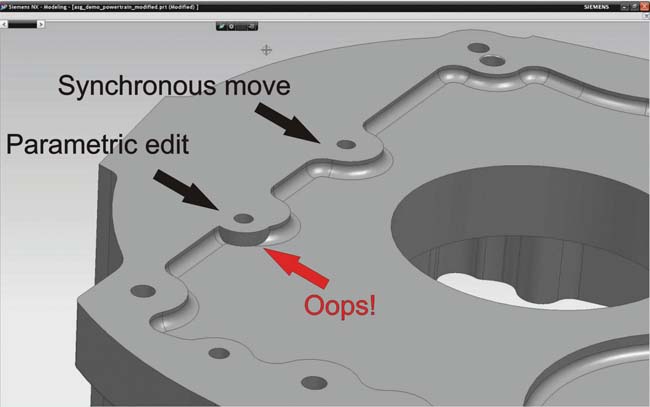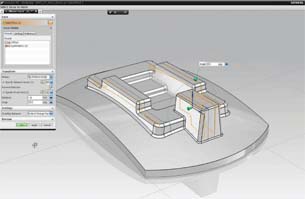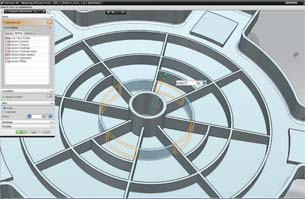Siemens PLM’s NX 7: The Best of Both Worlds
Enhancements to synchronous technology enable users to alternate between parametric and explicit modeling for easier and faster design.
Latest News
February 1, 2010
By Mike Hudspeth
Just like Hannah Montana, users of NX 7 get to work in two separate realms and pass between them seamlessly. Hannah (if you don’t know who she is, ask your child, grandchild, or niece) alternates between her teenaged pop-star identity and her secret country-girl identity so she can lead an ordinary life…in Malibu. NX 7 users alternate between parametric and explicit modeling so they can design great products easier and faster. As in Hannah’s theme song, they get the best of both worlds.
 Figure 1: The first boss was moved parametrically, revealing other features built beneath it. The same thing happened on the underside of the model, increasing the complexity and time of the change. The second boss feature was moved with synchronous technology in one fell swoop. |
One world, that of parametric modeling, is completely controlled. When changes are made to a design, you must follow the rules set up by the original modeler. In the other world, that of explicit modeling, you deal with the actual topology of the design’s geometry and there are no defined rules; you can change anything, at any time, in any way you want. And changes might be made that go against the original designer’s intentions. The one world is fairly rigid. The other is very flexible.
Synchronous Technology
Designers using NX 7, from Siemens PLM Software, get the best of both via synchronous technology. Synchronous technology (introduced in NX 6, but enhanced in the new version) allows the modeler to use parameters to set up the model according to whatever rules he needs to apply, then go back in and make changes that don’t affect the model’s sketches or the parameters used in feature creation.
 Figure 2: When you set up the Face Finder to look for symmetrical faces it will allow you to establish a relationship between them on the model. |
Theoretically you would always get it right the first time, but in the real world, changes will need to be made because you can never account for everything in the life of your part. And, when a change order comes in, it’s seldom that the original modeler will be doing the work, so even when you are diligent with your models, there are going to be things that will be hidden (see Figure 1), complicated, or waiting to explode. Therefore, you need access to the model’s topology.
Then there are the times when you get a model from somewhere else. Company acquisitions and outsourcing mean you are constantly having to work with files made offsite with other modeling systems. One of these days you will be able to open them right in your software and recognize all of its intelligence, but until that time comes, you will generally find only the model’s topology—its shape data—with no parameters. It will be a dumb solid.
The synchronous technology (ST) in NX 7 does a great job of recognizing features and even geometric conditions. For example, if the part you open has symmetrical features, ST will use Face Finder to look at the model’s topology and recognize them and treat them accordingly (see Figure 2). It gives you a list from which you can specify the conditions you want to see. You can turn conditions on or off as you see fit.
Up until now, dealing with unparameterized models has been difficult: while you have always been able to move faces, oftentimes it didn’t work because you would have to move them beyond their edges. Compounding that was the fact that blended edges would explode because the program tried to add or delete some edges. The system just didn’t know how to handle them. You then had to build new geometry to apply a patch of sorts onto the model—a long and tedious process. Now, synchronous technology enables you to drag most faces just about anywhere you want—and the blends then update without trouble.
A change made in NX 7 is faster to implement than traditional modeling because with ST you don’t have to update the whole feature tree. It just adds a feature to the bottom. Siemens says that ST is about getting the parts out the door—and we can all appreciate that. There are many other functions in NX 7 that make it worth your while. You can replace faces—just like you’ve always been able to do—but without building any new geometry and you can also apply an offset right in the command. So you end up with a different face that takes its shape from the extension of an existing one. Cool, huh?
 Figure 3: Sometimes you want to stagger ribs for structural strength. Synchronous technology allows you to do that with a simple cut and paste—and a change in radius. |
3D Dimensioning
Another exciting, brand-new capability debuting in NX 7 is 3D dimensioning. Here, you can create persistent relationships between faces much like you can in a sketch. For a blend—even one that is unparameterized—NX 7 enables you to directly access the theoretical underlying edge. (How long have we waited for that?) You can then lock the dimension against inadvertent changes (currently, there is no visual cue that dimensions are locked, but I am told you’ll probably see an icon or color change for that in NX 7.5). You can link 3D dimensions and even bring those dimensions onto your drawing. You can edit a model by making a 2D section and then editing the cut edges like a sketch. (This “sketch” is transient so don’t waste your effort fully dimensioning it. Just put on what you want to change.)
NX 7 functionality makes modeling easier whether you are creating your own geometry or editing someone else’s. You can create all sorts of features by cutting and pasting (see Figure 3). Once you paste a feature, you have the option of making changes to it—such as resizing or rotating it. It’s like a user-defined feature (UDF) but with less work involved. You don’t have to constrain things the way you would with a UDF. Call it scrapbook modeling; you can create a library of custom chunks to paste into your models. Synchronous technology patterns differ from regular patterns in that you don’t have to edit the original instance to make a change to the pattern. Any instance will do as they are all linked.
At the assembly level you can select faces from multiple parts and everything moves. NX 7 treats the assembly almost as if it were a part file. You can create symmetry in particular areas of your model instead of the entire thing. Say, for example, you are creating a snap feature at the edge of a thermo-formed tray. You can specify the center of a slot as the plane of symmetry and build mirrored features around it, giving you more control. It used to be that the smart modeler would hold off blending a model until the very end. Now blends are no longer problematic. NX 7 will handle most conditions without trouble. You can even build your own chamfer out of faces that are already on the model.
HD3D
NX 7 has what Siemens calls HD3D (for high-definition 3D). This allows you to do Dynamic Visual Reporting whereby you query your model or assembly for information and the results appear in the graphics window. You can tag things to see where and what they are. NX 7 tags are aware of what’s near and far to avoid clutter. And the tags are interactive so when you click on them they will expand to give you detailed information. With NX Check-Mate—you can create reports that sort by everything from “supplier” to “heavier than.” You can even keep track of what parts are completed and released to production and which ones are behind schedule. You can then export the results to wherever you need to, including Excel and other formats so you can access your data without having Siemens’ Teamcenter product (which would add even more power and flexibility). In the future you’ll be able to get info from many databases, and that’ll mean you can draw information from all across your organization directly into NX.
While NX 7 sounds like a big release (it’s actually more of an incremental one), look for NX 7.5 to include more industrial design enhancements to make styling easier. NX 7.5—due sometime in mid 2010—will recognize cliff-edge blends. Make no mistake, though, there’s so much more in NX 7 than there’s room to explore here, yet prices for NX 7 haven’t really changed from NX 6. They depend on what packages you get, but in general NX 7 starts around $9,000.
NX 7 functionality has definite real-world applications, enabling users to accomplish things they’ve wanted to for years. NX 7 has real multiCAD functionality, so you can pull—and actually use—geometry from anywhere. Because it can use both parametric and explicit geometry and still build flexible and truly useful models, NX 7 really is the best of both worlds.
More Info:
Siemens PLM Software
Mike Hudspeth, IDSA, is an industrial designer, illustrator, and author who has been using a wide range of CAD and design products for more than 20 years. He is DE’s expert in ID, design, rapid prototyping, and surfacing and solid modeling. Send him an e-mail about this article to [email protected].
Subscribe to our FREE magazine, FREE email newsletters or both!
Latest News






